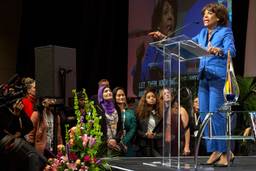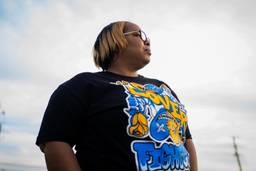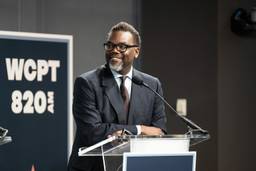The Next Steps for the Women’s March? Moving a Progressive Agenda.
After year one of the Trump presidency, women are furious. Now, many are asking where we go from here.
Jordan Sarti and Hannah Steinkopf-Frank

At the 2018 Chicago Women’s March, Mujeres Latinas en Accion community leader Frances Velez marched with members of the longstanding Latina empowerment organization, sporting glittery eyeliner and holding a sign that read, “They tried to bury us. They didn’t know we were seeds!”
Velez’s path to empowerment wasn’t easy. Ten years ago, she turned to Mujeres as a survivor of domestic abuse. Now, she’s an activist. As she says, “If I can do it, anybody else can do it.”
Velez was one of hundreds of thousands who gathered on January 20 for Women’s Marches across the country that rivaled 2017 crowds — in a clear rebuke of year one of Trump’s presidency. March organizers had no small task: transforming the raw nerve of last year’s historic demonstrations into a movement.
The 2017 Women’s March kicked off a year of activist efforts against the travel bans and Republican attempts to reform healthcare, taxation and immigration. Now, with the #MeToo movement ousting men who abuse their power — and opening space for women’s leadership — the question of the 2018 marches is how to galvanize that spirit for long-term change. This year, march attendees were more focused on action — and more informed about what a Trump presidency means.
Yet, in Chicago, organizers prioritized turning out the vote for the Democratic Party without consistently pushing a conversation about what it looks like to bring progressive politics to the electoral arena. But this did not stop grassroots organizers from bringing their own progressive politics to the march — and mobilizing their members to join and engage the historic gathering.
For the 2018 Chicago March, Liz Gomez, who is part of the National Youth Art Movement Against Gun Violence, painted a 1970s-inspired sign as a nod to the “energy, power and vivaciousness” of women of color, she told In These Times. As an Afro-Latina woman, she said it’s important to show up in spaces like the Women’s March that have been criticized for a lack of intersectionality.
“I feel the stakes are higher, because last year, it was before we really knew what was going to happen,” said Gomez, who went to Washington, D.C. for the 2017 march. “This year, it’s like, ‘We expressed that initial anger and frustration, and now, what are we going to do about it?’”
For both the national event in Las Vegas and local Women’s Marches around the country, the answer was clear: Get out the vote. And more importantly, make sure women are riding the 2018 blue wave in elections big and small.
Politics were front-and-center in the Windy City over the competitive 2018 race for the Illinois governor and other state and federal spots. Women in puffy jackets held clipboards and spoke about voter registration to waves of demonstrators entering Grant Park. The park was filled with expensive equipment, including a large stage, jumbotron and rows of speakers. Some of these items came courtesy of J.B. Pritzker, candidate for the Illinois Democratic primaries’ gubernatorial race.
Prior to the event, Chicago organizers told reporters 50,000 to 80,000 people had pre-registered online. By 1:00 p.m. on Saturday, an estimated 300,000 packed Grant Park. Despite the unpredictability in turnout, organizers touted the march as the most accessible outdoor public event Chicago has ever seen.
Michelle Garcia, who has cerebral palsy and is the Latino community organizer for Access Living, walked at the 2017 Chicago Women’s March. This year, she spoke at the pre-march rally with members of Chicago ADAPT, a disability justice group. Garcia asked the attendees if they or someone they knew had a disability. Many in the crowd raised their hands.
While she says she is grateful for the mainstage spot, Garcia told In These Times she wonders if people with disabilities would have been given the opportunity if they hadn’t been leading the fight to save Obamacare and Medicaid — and been the center of media coverage following their arrests.
“What if that wasn’t the case?” she said. “Would we still have been asked to speak? So I think even if you’re not at the forefront of the news, people should still be asked to be part of this movement that is being created.”
Besides Garcia, many of the speakers were local celebrities and elected officials — notably Cook County State’s Attorney Kim Foxx and Illinois Attorney General Lisa Madigan. The majority of speakers urged the crowd to vote, initiating an “elect more women” call-and-response and a chant of “Ruth Bader Ginsburg.”
Some were skeptical of the focus on electoral representation over policy.
“In Chicago [the focus on voting] translated into giving a platform to local politicians because they happen to be women, such as Lisa Madigan, who has positioned herself publicly as anti-sex worker,” noted Kathryn Rosenfeld, a member of the Board of Directors of the Sex Workers Outreach Project Chicago, which had a small contingent in the march.
Women’s March Chicago board member Ann Scholhamer told In These Times, “The energy and spirit ran high — but channeled from reactive and angry to focused and determined to change the face of democracy to reflect our communities. By having the experience of last year and roomfuls of partner organizations and advocates, our planning allowed us to have more services, sound and visual, and our footprint was able to be more condensed and everyone got to march to Federal Plaza.”
Responding to concerns about the lack of discussion about what truly progressive politics look like, Scholhamer said that speakers, messages on signs and comments in meetings, media and social media showed that “equal representation and progressive issues go hand in hand.”
The event’s last speaker was Suzette Wright, a former Ford assembly plant employee who lost her job for speaking out against sexual harassment on the job. In the wave of celebrity #MeToo stories, Wright’s experiences, highlighted in a New York Times feature, showcases the sexism faced by women outside of Hollywood and Washington.
The potential of an inclusive #MeToo movement was clear: In 2017, Wright was one of the thousands of attendees at Women’s March Chicago. In 2018, she closed out the rally. It was a refreshing moment after two hours of speeches and set the tone for a march that saw hundreds of thousands take the streets of downtown Chicago.
Yet, the dominant message of “power to the polls” often lacked nuance. As In These Times noted when covering the 2017 Women’s Convention in Detroit, giving prominent space to groups like EMILY’s List (a staff member spoke during the Chicago rally) raises the question of whether representation is being valued over progressive change. While EMILY’s List has played a role in increasing the number of women in Congressional seats, it has been criticized for endorsing female candidates with conservative economic policies.
But for some, the speeches and messaging were less important than the collective spirit of marching.
“I think the reason people come out for the most part is to march in the street and wave a sign and chant and feel togetherness, and not to be all kumbaya about it, but that is really important,” said Rachel Zibrat, the Feminist Working Group co-chair of the Democratic Socialists of America (DSA), which had approximately 25 members marching. “I think that’s what we’re trying to tap into as socialists, and even if the polls are big at this march, it’s still a moment that I think is important.”
Some organizations used the march as an opportunity to shine a light on specific campaigns. Jewish Voice for Peace (JVP) and the U.S. Palestinian Community Network highlighted the case of Ahed Tamimi, a 16-year-old Palestinian activist recently arrested by Israel for slapping an Israeli Defense Forces soldier.
“Issues of peace and justice are women’s issues, because women are of course half the population,” said JVP’s Lesley Williams.
While the march’s groundswell of many first-time activists comes with a learning curve, some on the Left are hopeful.
“Settle in for the long haul,” advised SWOP’s Rosenfeld. “Understand that elections are only one small part of the work, and that simply ‘electing more women’ is insufficient as a strategy. Most importantly, understand the limitations and failings of white liberal feminism. Focus on how this movement can center the needs of the most marginalized, including sex workers, and their particular reasons for needing feminism.”





